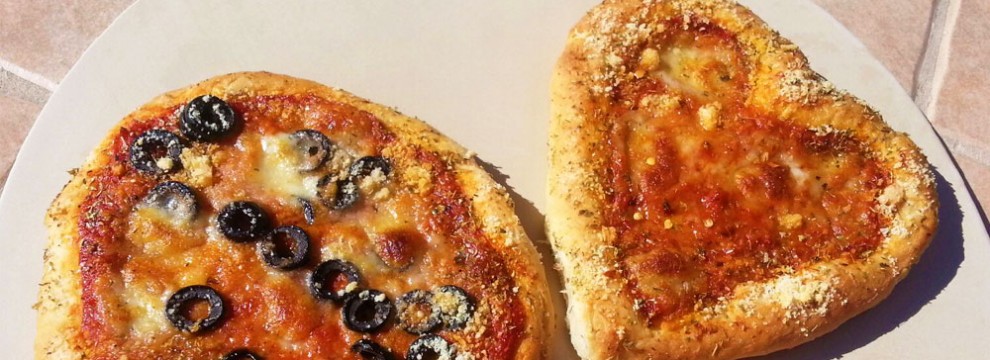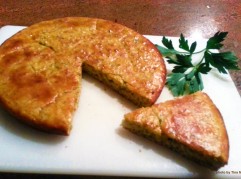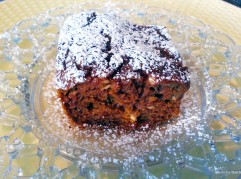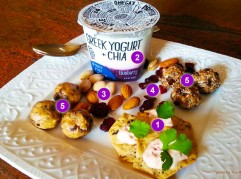Pizza with Gluten Free Crust
![]() This is a pizza crust I developed for one of my “Corporate Lunch and Learns”. GF recipes can be unstable and difficult for novice bakers. Mine is different; a crust that is fast to make and easy to handle.
This is a pizza crust I developed for one of my “Corporate Lunch and Learns”. GF recipes can be unstable and difficult for novice bakers. Mine is different; a crust that is fast to make and easy to handle.
by Tina Martini, The Medicine Chef
Ground flax seeds and a chia slurry give this crust structure and stability, while maintaining a light, airy crispiness. It also has the much desired “chew factor”, that all the best Napolitano-style pizzas has. Your family will say, “Pi’u la pizza per favore!, More pizza, please!”
Crust
- 1-1 1/2 Cup GF Beer, room temp (Just enough liquid to bring the dough together)
- 1 tsp Dry Yeast
- 3 cups GF all purpose flour
- 1 Tbls Ground Flax seeds
- 2 tsps Salt
- 2 1/2 tsps Baking Powder
- 1/4 cup Olive Oil
- 2 Tbls Chia Seeds, bloomed in 1/2 cup Water
Directions
- Prepare two rimmed cookie sheets with parchment lightly sprayed with olive oil
- In a small mixing bowl, pour 1 cup of beer in and sprinkle yeast over beer. Set aside.
- Stir or mix flour, flax seeds, salt and baking powder together. When using a stand mixer, the paddle will give the best results; or use a wooden spoon to mix by hand.
- With mixer running, slowly stream in beer/ yeast mixture.
- Add olive oil and chia slurry. All GF dough tends to be sticky. Do not over mix as this leads to a tough crust.
- Lightly coat a large mixing bowl with olive oil. Place dough in bowl, and cover with plastic wrap.
- Allow to rest in a warm place for 75-90 minutes.
- When dough is puffed (it doesn’t rise the same way traditional crust does) divide in half.
- Place each piece of dough on the prepared cookie sheets. Brush a small amount of olive oil over the top of each. Cover with plastic wrap and press dough into desired thickness and shape.
- Bake at 325 degrees for 45 minutes.
- Remove from oven and slide pre-baked crusts to a wire cooling rack. From here, crusts can hold at room temperature up to four hours.
- When completely cooled, wrap in plastic and then in foil.
- Freeze up to one month.
- Remove frozen crusts and top with sauce and other toppings.
- Bake at 500 degrees for 10-12 minutes using a preheated pizza stone or cookie sheet.
For fresh crust on the day of: One hour before baking, place your pizza stone in middle of oven and then heat to 500 degrees. Top pre-baked crust with sauce and toppings and slide pizza onto the heated stone. Bake as directed above, or until any cheese is golden and bubbly.
Sauce
- 1 28 oz can San Marzano Tomatoes
- 2 Tbls Tomato Paste
- 1 Tbls Basil*
- 1 Tbls Oregano*
- 1 Tbls Thyme*
- 3/4 tsp Red Chili Flakes (Optional, but very traditional)
- 2 tsps Balsamic Vinegar
*The sauce is very herbaceous at this measurement. Decrease to 2 tsps if you don’t want the herbal flavor at the front of the palate.
Directions
- Mix all ingredients in a large saucepan, except vinegar.
- Cook over medium heat mashing and stirring the tomatoes as the sauce reduces.
- Cook 30-40 minutes or until moisture is gone and sauce is very thick.
- Remove from heat and stir in vinegar.
- Set aside until ready to assemble and bake your masterpiece!
Phyto Facts– Celiacs vs. Coeliacs-Most of us have heard of Celiacs disease by now with the marked increase in the mainstream population. Most of us, however, have never heard of Coeliac Disease. Coeliac is derived from the Greek word, “Koiliakos,” meaning, “to suffer in the bowels.” Grains and other fibrous foods pass through the stomach and upper intestines in their crude form. This causes great pain, acid reflux, and indigestion in general. The inflammation caused from this poor digestion is painful along with the host of other side effects that go along with being Coeliac. But it is not fatal like Celiacs can be. It all comes down to the inability to break down gluten and other plant proteins. Gluten is the general name for the proteins found in grains. The three grains that are the highest in gluten are wheat, barley and rye. Other grains such as kamut, duram, spelt and farina are cousins of wheat and can cause irritation and inflammation, particularly in those with Celiacs disease. The mass production of wheat has genetic consequences: there is mounting evidence that the genetic modification of our grains is leading to a marked increase in inflammation of the digestive tract and brain, as seen in Autism. Clinical depression, Parkinson’s, ALS, Alzheimer’s/Dementia and the slow output of leptin (the fat burning hormone) are all being connected to GMO grain in the latest research.
The herbs we’re using are high in apigenin. I’ve written about the research concerning its powerful effect on ovarian cancer. Apigenin also calms anxiety and is showing promise as a protective agent for strengthening the brain in a fetus. There are many case studies linking a chronically agitated nervous system to clinical depression later in life. Omega-3’s and apigenin are critical to avoiding this in adults and children. Besides our leafy herbs, flowers are very high in this phytonutrient. Think chamomile tea. Mommies, please check with your OB/GYN to confirm a nightly cup of Chamomile fits with your prescribed regimen. Here’s to babies that sleep through the night!
Lycopene in the sauce is the way to keep those babies from aging us prematurely. It is one of the best internal beauty secrets we have. Lycopene reduces sun damage and slows aging. ![]()
 |
by Chef Tina Martini, “The Medicine Chef” @MedicineChef | Facebook Chef Martini is an experienced, well-versed television personality with a successful and proven track record. She holds a doctorate from Bastyr University in Naturopathy and a Nutrition degree from San Diego State University. She mixes cooking with nutrition, fitness and wellness! |











Leave a Reply
Want to join the discussion?Feel free to contribute!